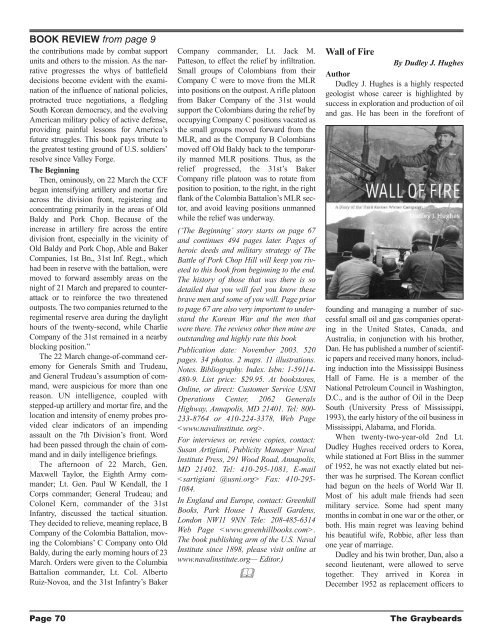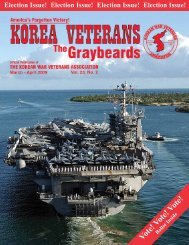The Graybeards - Korean War Veterans Association
The Graybeards - Korean War Veterans Association
The Graybeards - Korean War Veterans Association
Create successful ePaper yourself
Turn your PDF publications into a flip-book with our unique Google optimized e-Paper software.
BOOK REVIEW from page 9<br />
the contributions made by combat support<br />
units and others to the mission. As the narrative<br />
progresses the whys of battlefield<br />
decisions become evident with the examination<br />
of the influence of national policies,<br />
protracted truce negotiations, a fledgling<br />
South <strong>Korean</strong> democracy, and the evolving<br />
American military policy of active defense,<br />
providing painful lessons for America’s<br />
future struggles. This book pays tribute to<br />
the greatest testing ground of U.S. soldiers’<br />
resolve since Valley Forge.<br />
<strong>The</strong> Beginning<br />
<strong>The</strong>n, ominously, on 22 March the CCF<br />
began intensifying artillery and mortar fire<br />
across the division front, registering and<br />
concentrating primarily in the areas of Old<br />
Baldy and Pork Chop. Because of the<br />
increase in artillery fire across the entire<br />
division front, especially in the vicinity of<br />
Old Baldy and Pork Chop, Able and Baker<br />
Companies, 1st Bn,, 31st Inf. Regt., which<br />
had been in reserve with the battalion, were<br />
moved to forward assembly areas on the<br />
night of 21 March and prepared to counterattack<br />
or to reinforce the two threatened<br />
outposts. <strong>The</strong> two companies returned to the<br />
regimental reserve area during the daylight<br />
hours of the twenty-second, while Charlie<br />
Company of the 31st remained in a nearby<br />
blocking position.”<br />
<strong>The</strong> 22 March change-of-command ceremony<br />
for Generals Smith and Trudeau,<br />
and General Trudeau’s assumption of command,<br />
were auspicious for more than one<br />
reason. UN intelligence, coupled with<br />
stepped-up artillery and mortar fire, and the<br />
location and intensity of enemy probes provided<br />
clear indicators of an impending<br />
assault on the 7th Division’s front. Word<br />
had been passed through the chain of command<br />
and in daily intelligence briefings.<br />
<strong>The</strong> afternoon of 22 March, Gen.<br />
Maxwell Taylor, the Eighth Army commander;<br />
Lt. Gen. Paul W Kendall, the I<br />
Corps commander; General Trudeau; and<br />
Colonel Kern, commander of the 31st<br />
Infantry, discussed the tactical situation.<br />
<strong>The</strong>y decided to relieve, meaning replace, B<br />
Company of the Colombia Battalion, moving<br />
the Colombians’ C Company onto Old<br />
Baldy, during the early morning hours of 23<br />
March. Orders were given to the Columbia<br />
Battalion commander, Lt. Col. Alberto<br />
Ruiz-Novoa, and the 31st Infantry’s Baker<br />
Company commander, Lt. Jack M.<br />
Patteson, to effect the relief by infiltration.<br />
Small groups of Colombians from their<br />
Company C were to move from the MLR<br />
into positions on the outpost. A rifle platoon<br />
from Baker Company of the 31st would<br />
support the Colombians during the relief by<br />
occupying Company C positions vacated as<br />
the small groups moved forward from the<br />
MLR, and as the Company B Colombians<br />
moved off Old Baldy back to the temporarily<br />
manned MLR positions. Thus, as the<br />
relief progressed, the 31st’s Baker<br />
Company rifle platoon was to rotate from<br />
position to position, to the right, in the right<br />
flank of the Colombia Battalion’s MLR sector,<br />
and avoid leaving positions unmanned<br />
while the relief was underway.<br />
(‘<strong>The</strong> Beginning’ story starts on page 67<br />
and continues 494 pages later. Pages of<br />
heroic deeds and military strategy of <strong>The</strong><br />
Battle of Pork Chop Hill will keep you riveted<br />
to this book from beginning to the end.<br />
<strong>The</strong> history of those that was there is so<br />
detailed that you will feel you know these<br />
brave men and some of you will. Page prior<br />
to page 67 are also very important to understand<br />
the <strong>Korean</strong> <strong>War</strong> and the men that<br />
were there. <strong>The</strong> reviews other then mine are<br />
outstanding and highly rate this book<br />
Publication date: November 2003. 520<br />
pages. 34 photos. 2 maps. 11 illustrations.<br />
Notes. Bibliography. Index. Isbn: 1-59114-<br />
480-9. List price: $29.95. At bookstores,<br />
Online, or direct: Customer Service USNI<br />
Operations Center, 2062 Generals<br />
Highway, Annapolis, MD 21401. Tel: 800-<br />
233-8764 or 410-224-3378, Web Page<br />
.<br />
For interviews or, review copies, contact:<br />
Susan Artigiani, Publicity Manager Naval<br />
Institute Press, 291 Wood Road, Annapolis,<br />
MD 21402. Tel: 410-295-1081, E-mail<br />
Fax: 410-295-<br />
1084.<br />
In England and Europe, contact: Greenhill<br />
Books, Park House 1 Russell Gardens,<br />
London NW11 9NN Tele: 208-485-6314<br />
Web Page .<br />
<strong>The</strong> book publishing arm of the U.S. Naval<br />
Institute since 1898, please visit online at<br />
www.navalinstitute.org— Editor.)<br />
<br />
Wall of Fire<br />
By Dudley J. Hughes<br />
Author<br />
Dudley J. Hughes is a highly respected<br />
geologist whose career is highlighted by<br />
success in exploration and production of oil<br />
and gas. He has been in the forefront of<br />
founding and managing a number of successful<br />
small oil and gas companies operating<br />
in the United States, Canada, and<br />
Australia, in conjunction with his brother,<br />
Dan. He has published a number of scientific<br />
papers and received many honors, including<br />
induction into the Mississippi Business<br />
Hall of Fame. He is a member of the<br />
National Petroleum Council in Washington,<br />
D.C., and is the author of Oil in the Deep<br />
South (University Press of Mississippi,<br />
1993), the early history of the oil business in<br />
Mississippi, Alabama, and Florida.<br />
When twenty-two-year-old 2nd Lt.<br />
Dudley Hughes received orders to Korea,<br />
while stationed at Fort Bliss in the summer<br />
of 1952, he was not exactly elated but neither<br />
was he surprised. <strong>The</strong> <strong>Korean</strong> conflict<br />
had begun on the heels of World <strong>War</strong> II.<br />
Most of his adult male friends had seen<br />
military service. Some had spent many<br />
months in combat in one war or the other, or<br />
both. His main regret was leaving behind<br />
his beautiful wife, Robbie, after less than<br />
one year of marriage.<br />
Dudley and his twin brother, Dan, also a<br />
second lieutenant, were allowed to serve<br />
together. <strong>The</strong>y arrived in Korea in<br />
December 1952 as replacement officers to<br />
Page 70<br />
<strong>The</strong> <strong>Graybeards</strong>
















